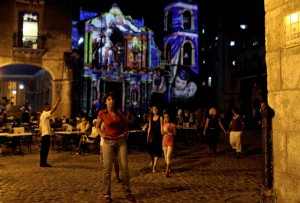Pope heads to Cuba to shore up Catholic Church

People walk past Havana's cathedral as images of Pope Benedict XVI by the French-Italian artist Gaspare Di Caro are projected on its facade in Havana, Cuba, on Sunday, March. 25, 2012. Benedict XVI will arrive in Cuba on Monday. AP PHOTO/FRANKLIN REYES
HAVANA, Cuba—Benedict XVI heads Monday to Cuba, where the Catholic Church has minority status but maintains a special dialogue with the communist regime, in the absence of legal opposition.
Benedict XVI, who made his first visit to Mexico at the weekend, set the tone for the Cuba trip by insisting Marxism “as it was designed, no longer corresponds to reality,” and it would be useful to “find new models” of governing.
He said Friday that Catholics were ready “to help in a constructive dialogue necessary to avoid trauma” in multi-denominational Cuba.
But the pontiff said it was “obvious that the Church is always on the side of freedom of conscience, freedom of religion” and that in Cuba, “ordinary Catholics contribute to finding the path forward.”
However, nobody expects a clash between the pontiff and the Cuban government, even as it continued a crackdown on opponents.
Article continues after this advertisementAt least 70 dissidents have been arrested by Cuban authorities in an effort to stop a demonstration during Benedict XVI’s visit, opposition sources said.
Article continues after this advertisementAt least 15 of those detained were members of the Ladies in White, a prominent group of wives and family members of jailed political opponents, according to the dissidents.
The Cuban Human Rights and National Reconciliation Commission said the arrests took place in the eastern city of Santiago de Cuba, where the pope was due to arrive Monday.
Benedict XVI underscored his commitment to “absolute continuity” of the course laid out by the historic journey of Pope John Paul II on the island in January 1998.
“The Holy See knows the ideological positions of the Cuban government” and the government “is aware of the views of the Church,” said Archbishop Dionisio Garcia of Santiago de Cuba.
He said he did not believe the pope’s comments would have repercussions on the visit.
“The pope said something that is obvious,” the archbishop said. “Marxism, as it was designed, should be overstepped and revised, and not only in Cuba.”
Benedict XVI has no plans to meet with the opposition. The pope “knows the Cuban reality” and the fact “he meets with the opponents or not does not mean he is unaware” of their situation, Garcia said Saturday.
However, the Vatican said the pope would be “available” for a possible meeting with the father of the Cuban Revolution, Fidel Castro, who left power due to ill health in 2006.
Cuba’s Roman Catholics account for about 10 percent of the population of 11 million, after 40 years of official atheism ended in the 1990s. Evangelical Protestants are making inroads as elsewhere, but most Cubans identify most with AfroCuban belief systems, such as Santeria and Palo Monte.
Workers, racing against the clock, have pieced together a huge altar where Pope Benedict will say Mass later this week in sprawling Revolution Square. It has been the venue for countless mass rallies over almost five decades by the Communist government led until 2006 by Fidel Castro.
The altar was placed at the foot of the towering Jose Marti monument, which honors Cuba’s most important independence-era hero.
And the pope, after meeting with President Raul Castro, will look straight out at towering images of revolutionary icons Che Guevara and Camilo Cienfuegos plastered on government ministries.
The late Pope John Paul said Mass in Revolution Square in 1998 on the first papal visit to Cuba, ushering in smoother ties after decades of tensions between the Caholic Church and the Cuban state.
Now the Roman Catholic Church has evolved into the most influential non-state actor in Cuba, where the government controls the media and economy. It has mediated in events as sensitive as prisoner releases.
Among the popular preparations – workers paved the heavily used Rancho Boyeros Avenue that leads to Jose Marti International Airport, and other streets on which the bullet-proof, pearly white Popemobile will roll by.
But in contrast to John Paul II’s visit, Havana has not been supplied with much in the way of commemorative trinkets like T-shirts, pens or busts of the pontiff.
On Sunday in Mexico, Benedict sought to boost the Catholic faith in the face of violence and other challenges.
“There is no reason… to give in to the despotism of evil. Let us instead ask the risen Lord to manifest His power,” he said before Latin American bishops in the cathedral of Leon.
At a vast open-air Mass, the pope also referred to Christ the King, whose statue, a major Mexican icon, towered over Bicentennial Park where the event took place.
“His kingdom does not stand on the power of his armies subduing others through force or violence. It rests on a higher power than wins over hearts: the love of God,” he told an estimated crowd of more than half a million.
The Mass was a highlight on the 84-year-old pope’s last day in Mexico, on a visit which began in the shadow of his charismatic predecessor, who made the trip five times, but ended up drawing a swell of popular support.